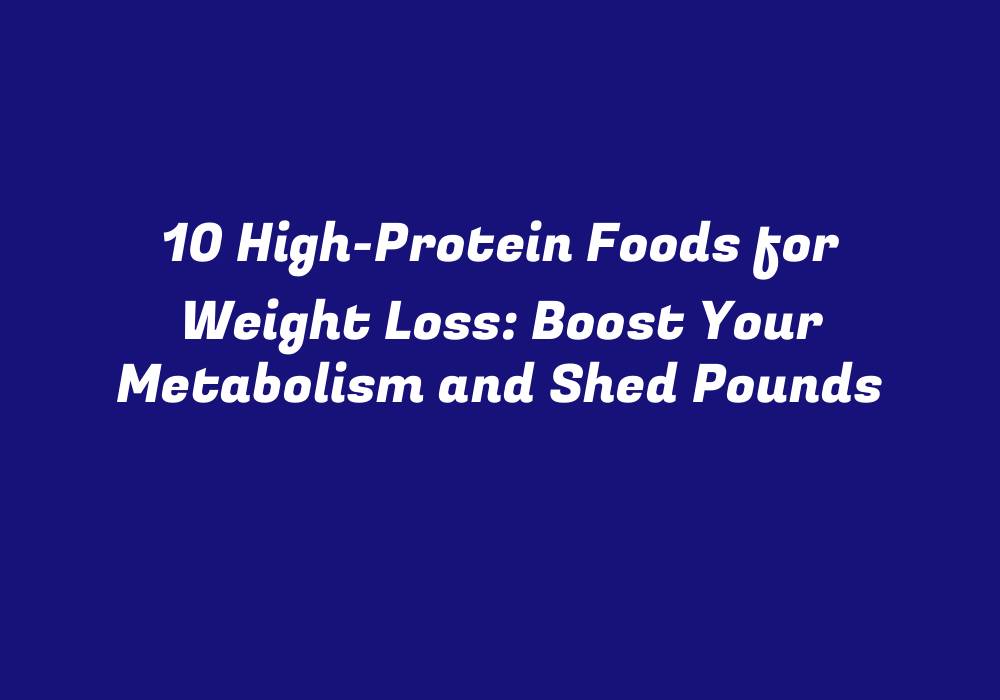10 High-Protein Foods for Weight Loss: Boost Your Metabolism and Shed Pounds
Weight loss can seem like a difficult task, often involving strict dietary plans, regular exercise routines, and endless frustration. However, there is a simple way to enhance your weight loss journey: incorporate high-protein foods into your daily meals. Protein plays a significant role in supporting our bodies by promoting satiety, boosting metabolism, and enhancing the growth of lean muscle mass.
The Role of Protein in Weight Loss
Protein is essential for maintaining bodily functions and supporting a healthy lifestyle. Its primary role in weight loss comes from its ability to help you feel fuller longer, reducing the urge to overeat or snack between meals. Moreover, protein also aids in building and repairing muscles, ensuring your body retains its strength during the weight loss process. As muscles grow stronger and become more efficient at burning calories, metabolism is improved, contributing to an overall increase in energy expenditure.
10 High-Protein Foods for Weight Loss
Eggs: A staple of many breakfasts, eggs are packed with protein and essential nutrients. Consuming whole eggs instead of just egg whites can provide additional health benefits while still offering a generous dose of high-quality protein.
Greek Yogurt: This creamy dairy product is an excellent alternative to traditional yogurts, as it has around twice the amount of protein per serving. Greek yogurt comes in various flavors and can be used as a versatile snack or breakfast item.
Lean Meats: Choosing lean cuts of meat such as chicken breast, turkey breast, pork tenderloin, and lean ground beef provide ample protein without the excess fat found in their higher-fat counterparts. These options can be easily incorporated into meals for a satisfying meal with minimal preparation.
Salmon: A well-known source of healthy fats and high-quality protein, salmon is an excellent choice for weight loss as it also contains essential nutrients such as vitamin B12, potassium, selenium, and omega-3 fatty acids. Try incorporating salmon into your meals a few times a week to reap the benefits.
Quinoa: A popular grain alternative, quinoa is not only high in protein but also gluten-free and rich in essential nutrients. It’s a versatile food that can be enjoyed as a side dish or used to create various recipes, making it an ideal addition to your weight loss plan.
Beans: An excellent source of plant-based protein and fiber, beans are known for their nutritional benefits. Add them to salads, soups, or incorporate them into main dishes such as chili or burritos to give your meals an extra boost of protein while keeping calories in check.
Peanut Butter: A great spread for whole-grain toast or apple slices, peanut butter offers a satisfying dose of protein. It also provides healthy fats and can be used to create various snack options like energy balls or as a smoothie addition.
Tofu: A popular vegetarian protein option, tofu is rich in protein and can easily replace meat in many recipes. Try using it in stir-fries, salads, and sandwiches for a satisfying yet light meal choice.
Edamame: These soybeans are packed with protein and fiber, making them an excellent addition to any weight loss diet. You can enjoy edamame as a snack or incorporate it into dishes such as sushi or pasta salads for added nutrition.
Chickpeas: These versatile legumes offer a healthy dose of protein and fiber, helping you feel fuller while providing essential nutrients to support your weight loss goals. Chickpeas can be used in various dishes such as hummus or incorporated into salads for added flavor and nutrition.
Tips for Incorporating High-Protein Foods
To make the most out of these high-protein foods, consider the following tips:
1. Plan your meals: Make sure to incorporate a variety of protein sources into your weekly menu plan. This will ensure you’re getting all the essential nutrients and can enjoy different flavors and textures throughout the week.
2. Be mindful of portion sizes: While it’s crucial to consume enough protein, be cautious not to overdo it. Stick to recommended serving sizes to avoid consuming excessive calories or fatty acids.
3. Pair with healthy fats and carbohydrates: Combine your high-protein foods with sources of healthy fats (like avocados or nuts) and complex carbohydrates (such as whole grains, fruits, and vegetables). This combination will help keep you feeling fuller longer and provide a balanced diet.
4. Be creative in the kitchen: Explore different recipes using high-protein foods to make mealtime more enjoyable. Look for ways to swap less nutritious options with healthier alternatives, such as using Greek yogurt instead of sour cream or swapping white rice for cauliflower rice.
5. Stay hydrated: Drinking enough water is crucial for proper weight loss and overall health. Aim to consume at least eight glasses a day to support your body’s functions and help reduce cravings.
By incorporating these 10 high-protein foods into your diet, you’ll be on your way to boosting metabolism, increasing satiety, and shedding pounds for a healthier lifestyle. Remember to focus on balance and variety while enjoying the benefits of these protein-packed options.
